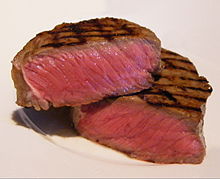- Temperature (meat)
-
"Medium rare" redirects here. For other uses, see Medium Rare.
Temperature is a description of how thoroughly cooked a cut of meat is based on the color, juiciness and internal temperature when cooked. The gradations of cooking are most often used in reference to beef (especially steak and roasts) but are also applicable to lamb, pork, poultry, veal, and seafood (especially fish).
Gradations, their description, and the associated temperature ranges vary regionally from cuisine to cuisine and in local practice and terminology. The table below is from an American reference book[1] and pertains to beef and lamb.
In lieu of gradations and ranges, the United States Department of Agriculture recommends a temperature of at least 63 °C (145 °F) for beef, veal, lamb steaks and roasts in order to prevent foodborne illness.[2]
USDA temperatures for beef, veal, lamb steaks and roasts Term (French) Description Temperature range[1] USDA recommended[2] Extra-rare or Blue (bleu) very red and cold 46–49 °C 115–120 °F Rare (saignant) cold red center; soft 52–55 °C 125–130 °F Medium rare (à point) warm red center; firmer 55–60 °C 130–140 °F 145 °F Medium (cuit) pink and firm 60–65 °C 140–150 °F 160 °F Medium well (bien cuit) small amount of pink in center 65–69 °C 150–155 °F Well done gray-brown throughout; firm 71-100 °C 160-212 °F 170 °F Overcook blacken throughout; crispy >100 °C >212 °F >220 °F The interior of a cut of meat will still increase in temperature 3–5 °C (5–10 °F) after stopped being cooked. The meat should be allowed to "rest" before being served, which allows for the juices in the center to return to the edges. The whole meat, and the center will also continue to cook slightly as the hot exterior continues to warm the comparatively cooler interior. The temperatures indicated above are the peak temperature in the cooking process, so the meat should be removed from the heat source a few degrees cooler.
Contents
Color
As meat is cooked, it turns from red to pink to gray to brown to black (if burnt), and the amount of red liquid, myoglobin (not blood), and other juices decreases. The color change is due to changes in the oxidation of the iron atom of the heme group in the myoglobin protein: raw meat is red due to myoglobin protein in the muscles, not hemoglobin from blood (which also contains a heme group, hence the color). Prior to cooking, the iron atom is in a +2 oxidation state, and bound to a dioxygen molecule (O2), with a red color. As cooking proceeds, it loses an electron, moving to a +3 oxidation state, and coordinating with a water molecule (H2O), turning brown in the process.
Searing raises the meat’s surface temperature to 150 °C, yielding browning via different reactions: caramelization of sugars, and the Maillard reaction of amino acids. Raised to a high enough temperature, meat blackens from burning.
Drying
Well done cuts, in addition to being brown, are drier and contain little or no juices. Note that searing (cooking the exterior at a high temperature) in no way "seals in the juices" – water evaporates at the same or higher rates as unseared meat.[3] Searing does play an important role, however, in browning, a crucial contributor to flavor.
References
- ^ a b Green, Aliza (2005). Field Guide to Meat. Philadelphia, PA: Quirk Books. pp. 294–295. ISBN 1594740178.
- ^ a b "Beef...from Farm to Table". U.S. Department of Agriculture, Food Safety and Information Service. February 2003. http://www.fsis.usda.gov/FactSheets/Beef_from_Farm_to_Table/index.asp. Retrieved 2009-01-24.
- ^ McGee, Harold (April 20, 1992). The Curious Cook: More Kitchen Science and Lore. John Wiley & Sons. pp. 339. ISBN 0020098014.
Further reading
- Burton, Susan (June 16, 2010), "Shoe-Leather Reporting: A history of well-done meat in America.", Slate, http://www.slate.com/id/2256610/
Wikimedia Foundation. 2010.


